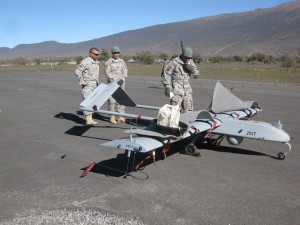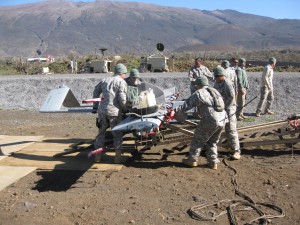Casting Shadows in the shadows
Posted on Feb 27, 2014 in FY2014, In The News, News ReleaseBy Col. Ed Toy, Deputy Brigade Commander 29th IBCT, Hawaii Army National Guard
Pohakuloa, Hawaii- Amongst the shadows and the crisp cold air between two of the tallest mountains in the world huddles a leader, his Soldiers and their Shadows. In this case, the Shadows are Unmanned Aerial Vehicles. Earlier this year, Lt. Col. James Barros, commander of the 29th Brigade Special Troops Battalion of the Hawaii Army National Guard and members of his Tactical Unmanned Aircraft System (TUAS) platoon conducted training flights for the first time at Pohakuloa Training Area (PTA) on Hawaii Island.

Lt. Col. James Barros, 29th Brigade Special Troops Battalion Commander looks on as 29th BSTB Soldiers Pfc. Matthew Romaine and Spc. Joel Keomalu prepare the Shadow for launch at Pohakuloa Training Area, Hawaii.
Maunakea and Maunaloa mountains provided the backdrop as the platoon prepared one of the first Shadows for flight. The RQ-7B Shadow 200 has a 14-foot wingspan, weighs 380 pounds and can stay aloft for more than five hours providing reconnaissance, surveillance and target acquisition. It is relatively small, lightweight and rapidly deployable short-range reconnaissance system capable of providing ground units with near real time video imagery day or night.
This key asset of the 29th Infantry Brigade Combat Team is a force-multiplier that can be integrating in a combined arms tactical mission where target acquisition and reconnaissance are vital to mission success. Paramount to the readiness of the TUAS platoon is the ability to train as often as possible in field conditions where the platoon can actual fly the Shadow. Given the inherit flight restrictions UAV platforms traditionally have in Hawaii, access to a premier training area like that at PTA is vital to the TUAS platoon’s proficiency in operating the Shadow. With a full complement of vehicle mounted command and control systems of the TUAS, Soldiers clearly see the value of training as frequently as possible to maintain their skill sets.
“The technical skill sets associated with this capability are perishable, it is essential to do hands-on training like this whenever possible,” said Lt. Col. James Barros. “Access to PTA and the small airfield specifically designed for UAS training is critical to our readiness.”
Launched from a mobile catapult system, the Shadow is capable of sustained flight for up to six hours with air speeds ranging from 60 to 110 knots. As a tactical capability for a brigade-sized headquarters, the Shadow is a versatile UAV with a suite of communications and full motion video components that make up the aircrafts modular mission payload.
To serve as one of the operators of the Shadow, these pilots had to complete the Army’s rigorous six month school at Fort Huachuca, Arizona in order to qualify for an assignment with the TUAS platoon. UAV operators are a small community in the Army, with many of the Soldiers having multiple tours in Iraq and Afghanistan supporting forward deployed ground combat units. In fact, there were Soldiers from the 25th Infantry Division training with the HIARNG operators during this particular field exercise on PTA.

Soldiers from the 29th Brigade Special Troops Battalion of the Hawaii Army National Guard ready the Shadow for launch on the mobile catapult at Pohakuloa Training Area, Hawaii.
“The Shadow offers another set of eyes for the commander,” said Chief Warrant Officer Chakib Benachour, a TUAS platoon member in Company B, 29th BSTB.
With more training, this can become a key platform for future training scheduled at PTA for active, guard, and reserve forces.
“Having the National Guard’s UAVs at PTA can be mutually beneficial for any other unit training here,” said Lt. Col. Eric Shwedo, garrison commander for PTA. “Because of the diversity of units that use PTA, the Hawaii Guard’s Shadows can be integrated into numerous joint and combined exercise scenarios.”
The uniqueness of PTA is that its remoteness lends itself well for maneuver training of ground and air units. Its high altitude austere conditions have been ideal training areas for Army and Marine units from around the Pacific in preparation for deployments to Afghanistan. Resembling that of a lunar or desert landscape, PTA is a special place. Mauna Kea is a dormant volcano on Hawaii Island. Standing 13,803 feet above sea level, its peak is the highest point in the U.S. However, much of Mauna Kea is below sea level; when measured from its oceanic base, its height is 33,100 feet. That’s more than twice Mount Everest’s base-to-peak height of 11,980 to 15,260 feet.
PTA has been a critical training site for our military forces stationed in the Pacific since WWII. If PTA was not available, no training could be accomplished. PTA provides UAS operators a larger “box” to operate in. The partnership between the active Army and the National Guard at PTA has been a long-standing relationship.
“We will continue to access PTA as a vital training area,” said Col. Steve Logan, Commander of the 29th Infantry Brigade Combat Team. “Our aim is to continue to utilize the Shadow and future weapon systems at PTA because it is an ideal training environment. As Guardsmen, we have our drills on weekends giving us little time to sustain our proficiency on technical systems like the Shadow. That is why our partnership with PTA is paramount to our readiness.” Col. Logan continued, “Our aim is to eventually support multiple units that will come together to synchronize a comprehensive combined attack scenario with artillery, helicopters, and ground forces- PTA is the right fit for our mission set.”